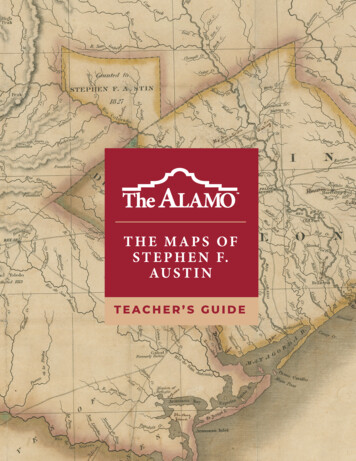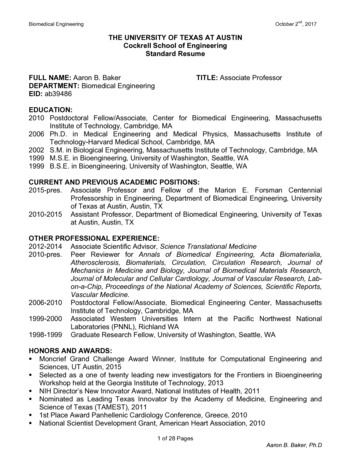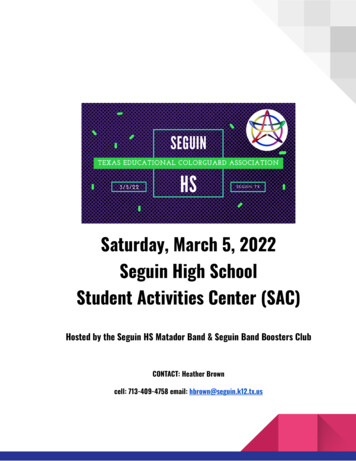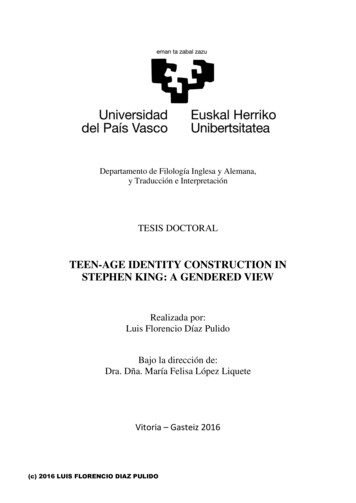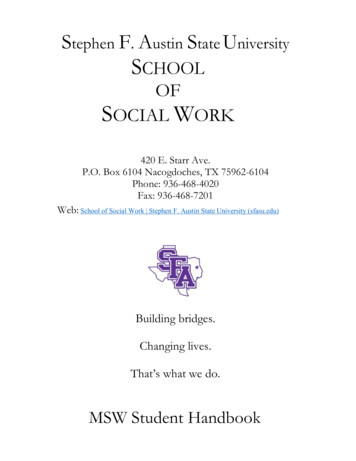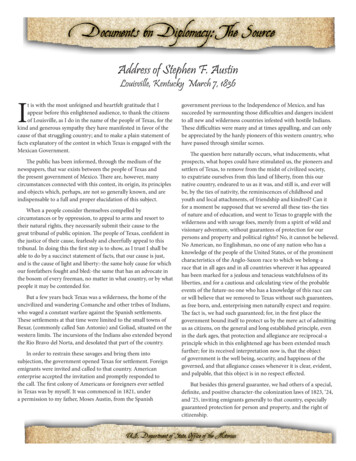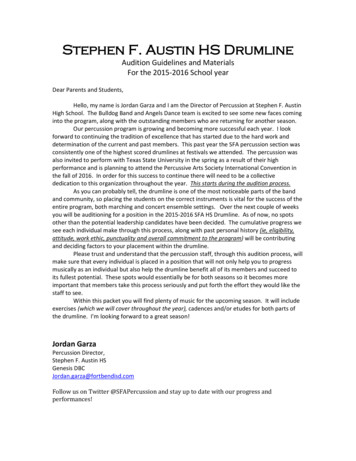
Transcription
Stephen F. Austin HS DrumlineAudition Guidelines and MaterialsFor the 2015-2016 School yearDear Parents and Students,Hello, my name is Jordan Garza and I am the Director of Percussion at Stephen F. AustinHigh School. The Bulldog Band and Angels Dance team is excited to see some new faces cominginto the program, along with the outstanding members who are returning for another season.Our percussion program is growing and becoming more successful each year. I lookforward to continuing the tradition of excellence that has started due to the hard work anddetermination of the current and past members. This past year the SFA percussion section wasconsistently one of the highest scored drumlines at festivals we attended. The percussion wasalso invited to perform with Texas State University in the spring as a result of their highperformance and is planning to attend the Percussive Arts Society International Convention inthe fall of 2016. In order for this success to continue there will need to be a collectivededication to this organization throughout the year. This starts during the audition process.As you can probably tell, the drumline is one of the most noticeable parts of the bandand community, so placing the students on the correct instruments is vital for the success of theentire program, both marching and concert ensemble settings. Over the next couple of weeksyou will be auditioning for a position in the 2015-2016 SFA HS Drumline. As of now, no spotsother than the potential leadership candidates have been decided. The cumulative progress wesee each individual make through this process, along with past personal history (ie, eligibility,attitude, work ethic, punctuality and overall commitment to the program) will be contributingand deciding factors to your placement within the drumline.Please trust and understand that the percussion staff, through this audition process, willmake sure that every individual is placed in a position that will not only help you to progressmusically as an individual but also help the drumline benefit all of its members and succeed toits fullest potential. These spots would essentially be for both seasons so it becomes moreimportant that members take this process seriously and put forth the effort they would like thestaff to see.Within this packet you will find plenty of music for the upcoming season. It will includeexercises (which we will cover throughout the year), cadences and/or etudes for both parts ofthe drumline. I’m looking forward to a great season!Jordan GarzaPercussion Director,Stephen F. Austin HSGenesis DBCJordan.garza@fortbendisd.comFollow us on Twitter @SFAPercussion and stay up to date with our progress andperformances!
Important DatesHere are the audition and camp dates and summer rehearsals for the upcoming drumline. Allauditions will be from 4:30 – 6:30PM (unless noted next to the dates) and will be held at Austinhigh school. Eighth grade percussionists/double reed players that are interested must attendALL of the drumline audition events if they wish to be considered for a ‘varsity’ spot. If studentsare not in attendance they will be automatically started in our ‘junior varsity’ band. If you havea school conflict, please email Mr. Garza at Jordan.garza@fortbendisd.com and we can find asolution. All of these events and more information can be found on our band calendar atwww.sfaband.org. Feel free to sync the calendar to your mobile device and stay up to datewith our calendar and all band events.You can also follow us on Twitter @SFAPercussionDate/Event:Section specific information:Notes:Drumline Audition Camp 1thMonday April 27 (4:30-6:30pm)All Percussion start togetherDrumline Audition Camp 2thMonday May 4 (4:30-6:30pm)At the end of the audition, I will beavailable for any question you wouldlike to ask in person (parents orstudents).All Percussion togetherDrumline Audition Camp 3thMonday May 11 (4:30-6:30pm)Begin splitting Battery/front ensemblePercussion Ensemble Concert!thMonday May 18 (7pm @RiverPointe)Drumline Audition Final CampthWednesday May 27 (4:30-6:30pm)Percussionists should attend theconcert.Marching Band Mini-CampJune 8-9 (8:00-5:00pm)Full Band Mini CampWe will begin our preparation, musicassignments during these two days.Marching Band Mini-CampJune 10 (8:00-6:00pm)Full Band Mini Camp/ PreviewPerformanceSFA Percussion CampJuly 27-31(8am – 5pm)All Percussion AttendAfter our rehearsal day, the studentswill showcase a portion of theirupcoming marching season.This begins summer band for thepercussion section.Split Auditions Battery/ FrontensembleThis concert is at River PointeAuditorium.5000 Ransom Rd, Richmond Tx, 77649Results posted on our Facebook page.
Frequently Asked Questions:What instruments make up the Drumline?The drumline is the term we use to call both large groups of the percussion section; thebattery and front ensemble. This word is often interchangeable.What is the battery? Front Ensemble?Here is an overview of the instruments in the BATTERY SECTION: All of these instruments are onthe field and march with coordinates during our show. These students are typically morecoordinated/ have more experience.Marching snare: This is probably the most demanding instrument musically in thedrumline. They must line up multiple notes in one beat with each other throughout the entireperformance. Failure to meet these requirements usually results in low percussion scores forthe entire group. The center snare drummer, along with the drum major is responsible forkeeping the tempo for the other 180 performers on the field.Tenors: This instrument consists of five drums that are bolted together and are playedwith sticks or tenor mallets. Tenors are the melodic instrument of the battery and are arguablythe most physically demanding instrument in the drumline. Their music is as demanding as thesnare drums but must split their targets across five (sometimes six) surfaces.Basses: The bass drums are played by five performers, each of whom carries their owndifferent drum. The melodic line is separated between five people and must be kept track of byeach performer. The parts are not always similar to the snare and tenor lines but they must beable to count accurately and play their set of notes in perfect time. Five people performing asone instrument.The next large section of the drumline is the FRONT ENSEMBLE: The front ensemble consists ofinstruments you find in a normal percussion ensemble. These groups carry the melody for thepercussion section and add general effect to the overall show performance.Marimba: The most experienced keyboard players tend to hold these positions. Mostthe parts are more difficult and often require four mallets. The center marimba player is incharge of keeping time for the front ensemble.Vibraphone: The vibraphones are often outside of the marimba players so they canlisten in. These parts are often melodic and also require four mallets.Xylophone: The instrument is the high voice of the front ensemble and usually doubleall the fast notes in the woodwinds and marimbas. The xylophone player should be able to playeverything the marimbas players do.Bells/Chimes/Crotales: These instruments are used to color the different sections of thefront ensemble. The performer must have good timing and the ability to line up notes withmultiple members at different times. These instruments are sometimes attached to otherinstruments in the front ensemble.
Percussion/Auxiliary Pods/Synths: These instruments consist of cymbals, gongs, bassdrums, sometimes synthesizer, brake drums, sizzles, and anything else the music requires.Percussion Pod players learn to have good timing and counting skills and be able to play manyinstruments with minimal time to switch in between. The synth players usually have somepiano experience and are responsible for a large portion of our electronic output on the field.Doesn’t this take up a lot of time?On a first glance this commitment will appear to take up a lot of your free time.Student’s grades are typically higher when they are required to stay busy. The Austin Drumlineis always being asked to perform at local events. All the great drumlines in the state of Texaspractice this often, if not MORE. Many of them even set the drumlines in November andperform in winter Drumline competitions as we mentioned earlier. We do an extensivepercussion ensemble concert. Each chapter of your life involves you having to grow personallyand work harder to achieve and meet your goals. In the drumline, you get to grow with greatpeople around you, learn how to better balance your schedule, and have fun doing it .and playpercussion!!How does the audition process work?The audition will take place in a group setting and all members will be a part of the percussionsection. Selecting their specific instrument will be done through a rotation process that will helpus identify where they will find a good balance between pushing themselves and having optimalsuccess as a percussionist. Students, here’s what you need to do to get started! I’m here if youneed help. You will need to schedule a time to get help from me if that is something you arewanting. I also have a percussion private lesson teacher who is nearby and still has someavailability. I highly recommend people taking lessons. Private instruction is almost invaluableto a growing musician. Email me at Jordan.garza@fortbendisd.com if you’re interested instarting private lessons with our HS instructor.EVERYONE Learn these materials first and have them prepared.FIRST AUDITION FOR MS:FIRST AUDITION FOR HS:All materials should be kept in a new binder with sheet protectors (so we can rehearseoutside). Student will need to purchase own sticks and or mallets for auditions and practice inbetween camps. We use ‘outdoor’ mallets which are weight differently and we use them to
build the appropriate amount of muscle. Please label your sticks so if they get misplaced weknow where to send them. We have some in case of emergency but definitely not for everyoneand the sticks are not of the highest quality because they are used. Any percussionist knowsthat sticks can potentially affect your sound. Always have a pencil and extra blank paper to takenotes about your performance.Stick model(s) from Salyers Percussion (www.salyerspercussion.com):For marching percussion we will use:MAS1 – Marching Snare SticksMAM40 – Marimba (2 pairs 4 mallets)MAT1 – Marching Tenor StickMAB1-5 – BassesFor Region Band and Concert Percussion percussionists will need:PCS1 – Concert Snare Drum sticksPCM30s – 2 pairs for a set of 4 mallets.Timpani Mallets - TBDThese items are available for purchase for your audition omwww.percussiononline.comHere is some advice to take into your practicing before you come in and audition. Probably themost important thing to remember is that the entire percussion staff wants you to besuccessful. However you have to put it the appropriate amount of time.Here are a few tips While you should spend some time practicing without a metronome, the MAJORITY of yourtime should be spent using one. Don’t teach yourself to play these exercises the wrong waybecause that would reflect poorly on your actual ability.Be prepared and know the exercises thoroughly. There aren’t many other things moredisappointing than someone who is obviously a talented player but is unsuccessful at theiraudition because of lack of preparation. Be able to play these exercises at slow AND fasttempos.Spend some time playing the exercises on a variety of surfaces. Battery, you can literallypractice anywhere (i.e. the ground, a table, a practice pad, different drums). Front ensemblethis means on either a marimba or a vibe or a xylophone. You can do a lot of conditioningtraining this way and it will come in handy if you have limited access to an instrument.Use the correct implement. We use outdoor sticks/mallets for the marching season and theyare significantly heavier and bigger to provide us with a bigger sound. Your hands won’t be
strong enough if you practice with baby drum set sticks. The list we provided above gives thecorrect model numbers of sticks to purchase for marching and concert percussion use.Be open to new ideas. Our approach to percussion is not the only one, just the one that worksbe best for us, while allowing us to move through the semester. If you want to be a part of thispercussion program there will be times where you have to adapt your ‘style’ of playing to theway we play to provide the ensemble with a uniform approach. There is always a techniquecategory for anything related to marching percussion.Music over matter. We often get into periods or building muscle and the technical chores ofbecoming proficient on our instrument. Although these aspects are important we have to stayin touch with why we’re doing it in the first place. LISTENING is a very important part ofexpanding your musical palette. Listen to a variety of music both percussive and not. It isequally as beneficial in becoming more intuitive behind your instrument.Practice with a metronome!!!! While learning all these exercises you need to start slow andfocus on rhythmic accuracy. Battery, you can even practice with popular music you like to listento as long as it has an easily identifiable pulse. While using a metronome also listen to how acertain sticking can affect your rhythmic integrity. Once you’ve heard it, eliminate it.You need to start building more chops. We play a lot and you must be constantly attaining newlevels of muscles in your hands. Use the tracks we have provided for you.Come with confidence. At the levels we are trying to reach, our performances must beauthentic and can’t have people trying to ‘fake’ anything. Confident players accept change withgrace and apply those changes almost immediately. Confident players also play with a level ofcalmness and relaxation that should feel reassuring to both the players and the listeners.Practice marking time. Rarely will the battery ever play without moving your feet. We startwith our left foot and alternate feet to the quarter note pulse. It’s important that you beginmoving your feet while you play the exercises.
General Technique GuidelinesPostureBefore you ever play your first note, you are judged on the way you look behind the instrument.The way we look not only sets us up to be successful players, but it also creates an atmosphereof professionalism to the listeners.You should be standing tall. Shoulders and legs relaxed and your torso should be tall andstraight. Battery with have feet together and Front will have their feet shoulder width apart.Unless you are reading music, your head should be floating above your shoulders.Instrument Height and Arm PlacementFirst, let your arms hang down by your side (with good posture). Bring your hands up to theinstrument either to the drum or the keys. Your forearms should be nearly flat while keep yourshoulders low and relaxed. The height of [almost] every percussion instrument is adjustable sowe want to fit the instrument to you, and not the other way around. Always make sure yourinstrument is adjusted before you play in the ensemble.Quality of Sound/ DynamicsYou must play through the drum/ keyboard while being as RELAXED AS POSSIBLE with consistentvelocities in order to achieve a good quality of sound. Sometimes players will change theirapproach to the drum when asked to change their dynamic level. Our dynamics will essentiallycome from stick heights and will be defined as follows:P 2 inches and often near edge/gutsmp 4 inchesmf 6 inchesf 9 inchesff 12-15 inches and often incorporates armListeningIn any percussion ensemble, especially in the marching percussion aspect, each player will haveto develop a fundamental sense of listening within their respective sections and ensemble.When you practice, listen to the actual sounds you are making. Are they appropriate? Are theyat the correct dynamic? Do you have good accents vs. taps?
Stephen F. Austin HS Drumline Audition Guidelines and Materials . For the 2015-2016 School year. Dear Parents and Students, Hello, my name is Jordan Garza and I am the Director of Percussion at Stephen F. Austin High School. The Bulldog Band and Angels Dance team is excited to see some new faces coming
